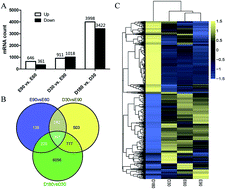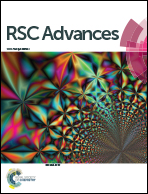Integrated analysis of miRNA and mRNA expression profiles in development of porcine testes†
Abstract
To understand the complex physiological process underlying pig testis development and spermatogenesis, this study aims to characterize the change in miRNA and mRNA profiles at four developmental stages of embryonic and postnatal testes, including 60 dpc (days post coitus, E60), 90 dpc (E90), 30-day-old (D30) and 180-day-old (D180). A total of 304 mature, 50 novel miRNAs, and 8343 differentially-expressed genes were identified. 93 (48 up and 45 down), 104 (49 up and 55 down), 122 (49 up and 73 down) differentially-expressed miRNAs, as well as 1007 (646 up and 361 down), 1929 (911 up and 1018 down), 7420 (3998 up and 3422 down) differentially-expressed genes were identified in E90 vs. E60, D30 vs. E90 and D180 vs. D30, respectively. Integrating analysis of miRNA and mRNA expression profiles predicted more than 50 000 miRNA–mRNA interaction sites. GO and KEGG pathway analysis of the predicted target genes illustrated the likely roles of differentially expressed miRNAs in testis development and spermatogenesis. For example, PI3K-Akt signaling pathway and Hippo signaling pathway related development, and carbon metabolism, fatty acid metabolism, protein digestion and absorption, were involved in metabolite synthesis. These integrated high-throughput expression data show that miRNA is a critical factor in porcine testis development, providing a useful resource to understand global genome expression change in porcine testis development and spermatogenesis.


 Please wait while we load your content...
Please wait while we load your content...